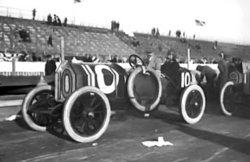Felice Nazzaro

Felice Nazzaro (Turin, Italy, 1881 - March 21, 1940) was an Italian racecar driver. He won the French Grand Prix in 1907 and 1922 and Targa Florio in 1907 and 1913. His European wins in 1907 resulted in an invitation to compete in the 1908 American Grand Prix in Savannah, Georgia where he finished third. He returned to the United states for the 1910 event but a damaged real axle forced him out of the race.
Nazzaro was very young when he started work in the workshop of the Ceriano brothers (Fiat founders) and he was soon competing for the new Fiat racing team. He won the Padua 200 km race in 1900 at the wheel of a red Fiat and the 1901 Giro d'Italia in a Fiat 6 HP. The popular star of numerous Italian races early in the century, he even became an idol abroad, with a brilliant second place for Fiat in the Gordon Bennett Cup of 1905. Slight of build, gentlemanly of nature and immaculate in dress, his skill as a driver, mechanic and diplomat earned him the position of 'works' Fiat driver alongside Vincenzo Lancia in 1905.
1907 was Nazzaro's greatest year. He won the three most important races in the world; the Targa Florio in a Fiat 28-40hp, the Kaiserpreis Kaiser's Cup in Germany in a Fiat Taunis and THE most important race on the calendar, the French Grand Prix in the Fiat 130hp F2 Racer.
On the 8 June 1908, Nazzaro set the auto speed record at 193kph for 2.75 miles and briefly exceeded 200kph, the first driver in the world to do so.
Felice Nazzaro, like Lancia and many other successful drivers of the period, also wanted to try his hand at producing cars. The First World War was looming and Fiat had begun to withdraw from racing, so in 1911, together with some colleagues, he founded Nazzaro & C.Fabbrica di Automobili in Turin. Initially his name was enough to ensure sales of the first model, the Tipo 2 powered by a 4.4 liter four cylinder side valve engine, which emerged in 1912. His race team, although generally beset with mechanical failures, had some notable success in motor sport. In 1913 he won the Targa Florio for the second time, driving a Nazzaro Tipo 2, putting no less than 3 hours between himself and the runner-up! A couple of years later an improved model, the Nizzaro Tipo 3 was released. The company organisation, however, was weak and along with the ravages of the war, the company went into liquidation in 1916, after having produced around 230 cars plus some 50 trucks. At the end of the war Nazzaro tried again, this time at Firenze. 210 examples the Tipo 5, a 3.5-liter overhead cam four-cylinder powered car were built and a Nazzaro GP car, driven by Meregalli, won the 1920 Targa Florio before Nazzaro finally gave up Nazzaro Automobili for good in 1923.
Meanwhile Fiat, who due to the war had all but stopped racing in 1912, had returned in 1921 and Nazzaro had joined the team again. His team mate was Pietro Bordino, who had been a riding mechanic for Fiat and who was now regarded as the world's fastest driver. But it was Nazzaro, now 42 years old and 9 years from the last time that he had raced in an important long-distance event, who won the 500 mile 60 lap 1922 French Grand Prix at the fast 8.3 mile Strasbourg circuit, driving the Fiat 804/404 2 liter six-cylinder racer. He had been at the wheel for 6 hrs 17 mins 17 secs and had averaged 79.2 mph for the 500 miles. He had also taken the fastest lap at 87.75mph. Only 3 of the 18 starters made it to the finish. After the win, it was remarkable how fresh Nazzaro seemed, but he was, as always, tireless. Sadly the race was not without tragedy for Nazzaro, when another Fiat, driven by his nephew, Biagio Nazzaro, broke a back axle shaft, lost a wheel and overturned with fatal results. Nazzaro had narrowly escaped death earlier in the year in an identical accident in the Targa Florio and after so many years at the pointy end of a very dangerous era in motor racing, he must have been seriously considering a quieter lifestyle. Later in the year he finished second to the young Bordino in the Italian Grand Prix and finished second again in the 1923 European GP in Italy, his last significant race result. Nazzaro would step aside for the younger Bordino at the end of 1923.
At the end of 1924 Fiat closed down their race team and Nazzaro was appointed head of the Fiat competitions department for existing cars in 1925 and continued until Fiat, after Bordino's spectacular one race comeback and GP win at Monza in 1927, finally withdrew from racing in 1929. We can only speculate on how many more races Nazzaro would have won, had the war not denied him 10 years of racing, at the peak of his driving powers. Tragically the world's greatest early century driver was at the wheel of his road car when he crashed and was killed in 1940. He was 59 years old. Source
Also See
